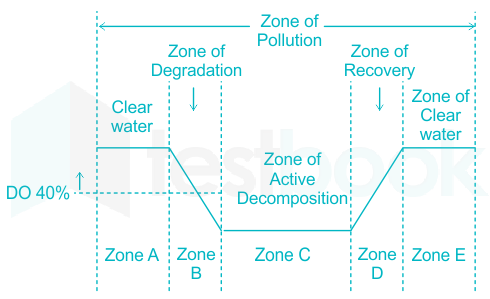- Zone of degradation: This zone is characterized by water becoming dark and turbid with formation of sludge deposits at the bottom.
- Zone of active decomposition: This is characterized by heavy pollution by water becoming grayish and darker than in the previous zone.
- Zone of Recovery: In this zone the river stream tries to recover from its degraded condition to its former appearance.
- Zone of cleaner water: In this zone river attains original conditions with DO rising up to the saturation value.

Indices of self-purification
Oxygen deficit (D) = Saturation D.O. – Actual D.O.
Deoxygenation curve: In a polluted stream, the DO concentration continues to drop as a result of volatile organic matter’s breakdown. The amount of organic matter still needing to be oxidised at any one time, as well as the reaction’s temperature, affect the rate of de-oxygenation.
Reoxygenation curve: The act of adding oxygen to water in order to balance out the loss of DO caused by deoxygenation is known as reoxygenation.
Curve of oxygen deficit: Deoxygenation and reoxygenation coexist in a flowing, polluted stream that is exposed to the atmosphere. An oxygen deficit will occur if deoxygenation outpaces reoxygenation.
Biological zones in lakes
- Euphotic zone: The upper layer of lake water where sunlight can enter is referred to as the euphotic zone.
- Littoral zone: The term “littoral zone” refers to the shallow water near the shore where rooted plants flourish.
- Benthic zone: A lake’s bottom sediments make up the benthic zone.
